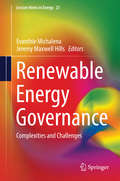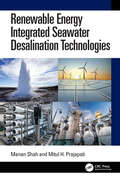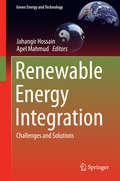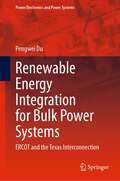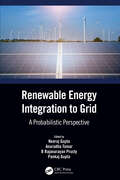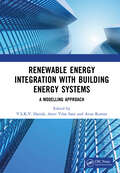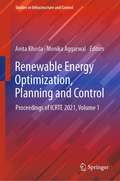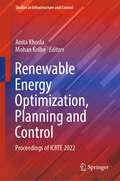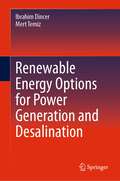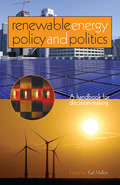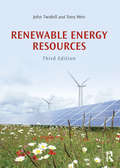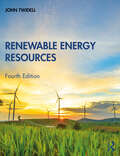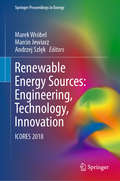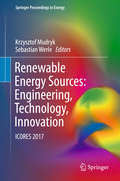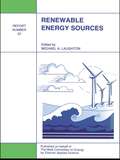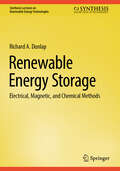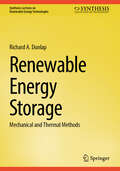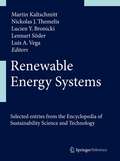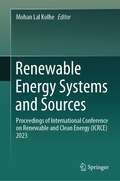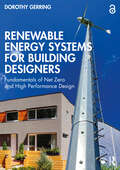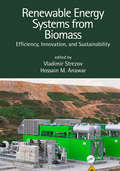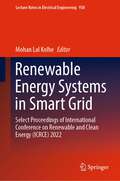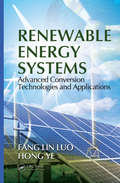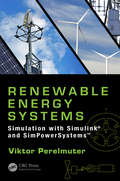- Table View
- List View
Renewable Energy Governance
by Evanthie Michalena Jeremy Maxwell HillsThis book focuses on Renewable Energy (RE) governance - the institutions, plans, policies and stakeholders that are involved in RE implementation - and the complexities and challenges associated with this much discussed energy area. Whilst RE technologies have advanced and become cheaper, governance schemes rarely support those technologies in an efficient and cost-effective way. To illustrate the problem, global case-studies delicately demonstrate successes and failures of renewable energy governance. RE here is considered from a number of perspectives: as a regional geopolitical agent, as a tool to meet national RE targets and as a promoter of local development. The book considers daring insights on RE transitions, governmental policies as well as financial tools, such as Feed-in-Tariffs; along with their inefficiencies and costs. This comprehensive probing of RE concludes with a treatment of what we call the "Mega-What" question - who is benefitting the most from RE and how society can get the best deal? After reading this book, the reader will have been in contact with all aspects of RE governance and be closer to the pulse of RE mechanisms. The reader should also be able to contribute more critically to the dialogue about RE rather than just reinforce the well-worn adage that "RE is a good thing to happen".
Renewable Energy Integrated Seawater Desalination Technologies
by Manan Shah Mitul H. PrajapatiThis book bridges the gap between conventional processes and renewable energy procedures by offering a comprehensive introduction to seawater desalination technologies.With a special focus on water quality, plant design, and the health and environmental impacts of desalination, it provides innovative solutions to optimize facilities for better accessibility to desalinated water. The first part provides a technical overview of seawater quality and desalination procedures, including thermal desalination, membrane desalination, and alternative processes like desalination batteries and capacitive deionization. The second part introduces novel freshwater production technologies using renewable energy, such as solar, wind, and geothermal desalination. With fresh insights from experts in the field, the book's value lies in providing valuable, accessible, and up-to-date knowledge about desalination to readers.This text will be of significant interest to professionals in water resource management, and academic researchers in desalination technology and environmental engineering.
Renewable Energy Integration
by Jahangir Hossain Apel MahmudThis book presents different aspects of renewable energy integration, from the latest developments in renewable energy technologies to the currently growing smart grids. The importance of different renewable energy sources is discussed, in order to identify the advantages and challenges for each technology. The rules of connecting the renewable energy sources have also been covered along with practical examples. Since solar and wind energy are the most popular forms of renewable energy sources, this book provides the challenges of integrating these renewable generators along with some innovative solutions. As the complexity of power system operation has been raised due to the renewable energy integration, this book also includes some analysis to investigate the characteristics of power systems in a smarter way. This book is intended for those working in the area of renewable energy integration in distribution networks.
Renewable Energy Integration for Bulk Power Systems: ERCOT and the Texas Interconnection (Power Electronics and Power Systems)
by Pengwei DuRenewable Energy Integration for Bulk Power Systems: ERCOT and the Texas Interconnection looks at the practices and changes introduced in the Texas electric grid to facilitate renewable energy integration. It offers an informed perspective on solutions that have been successfully demonstrated, tested, and validated by the Electric Reliability Council of Texas (ERCOT) to meet the key challenges which engineers face in integrating increased levels of renewable resources into existing electric grids while maintaining reliability. Coverage includes renewable forecasting, ancillary services, and grid and market operations. Proved methods and their particular use scenarios, including wind, solar, and other resources like batteries and demand response, are also covered. The book focuses on a real-world context that will help practicing engineers, utility providers, and researchers understand the practical considerations for developing renewable integration solutions and inspire the future development of more innovative strategies and theoretical underpinnings.
Renewable Energy Integration to the Grid: A Probabilistic Perspective
by Neeraj GuptaThis comprehensive reference text discusses uncertainty modeling of renewable energy resources and its steady state analysis. The text discusses challenges related to renewable energy integration to the grid, techniques to mitigate these challenges, problems associated with integration at transmission and distribution voltage level, and protection of power system with large renewable power integration. It covers important concepts including voltage issues in power networks, use of FACTS devices for reactive power management, stochastic optimization, robust optimization, and spatiotemporal dependence modeling. Key Features: Presents analysis and modeling of renewable generation uncertainty for planning and operation, beneficial for industry professionals and researchers. Discusses dependence modeling of multi-site renewable generations in detail. Covers probabilistic analysis, useful for data analysts. Discusses various aspects of renewable energy integration i.e. technical, economic, etc. Covers correlation factors, and methodologies are validated with case studies with various standard test systems. The text will be useful for graduate students and professionals in the fields of electrical engineering, electronics and communication engineering, renewable energy, and clean technologies.
Renewable Energy Integration with Building Energy Systems: A Modelling Approach
by Harish, V.S.K.V.Construction as an industry sector is responsible for around one-third of the total world-wide energy usage, and about 20% of greenhouse gas emissions. The rise in number of buildings and floor space area for both residential and commercial purposes has imposed enormous pressure on existing sources of energy. Implementations like efficient usage of building energy systems, design measures, utilization of local energy resources, energy storage and renewable energy sources for meeting electricity demand are currently under development and deployment to improve the energy performance index. However, integrating all such measures and evaluation of developed nearly zero-energy and zero-emission buildings is yet to be explored. In this book, different control techniques together with intelligent building technology used to improve the energy performance of buildings have been illustrated. Every building energy control system has a two-fold objective for energy and comfort requirements to achieve a high comfort index (for thermal, visual, air quality, humidity and various plug loads) and to increase the energy performance index. The most significant aspect of the design of buildings’ energy control system is modelling. All the components, methodologies and processes involved in developing a renewable energy-driven building are covered in detail. This book is intended for graduates and professionals working towards the development of sustainable built environment using renewable energy sources.
Renewable Energy Optimization, Planning and Control: Proceedings of ICRTE 2021, Volume 1 (Studies in Infrastructure and Control)
by Anita Khosla Monika AggarwalThis book gathers selected high-quality research papers presented at International Conference on Renewable Technologies in Engineering (ICRTE 2021) organized by Manav Rachna International Institute of Research & Studies, Faridabad, Haryana, India, during 15–16 April 2021. The book includes conference papers on the theme “Computational Techniques for Renewable Energy Optimization”, which aims to bring together leading academic scientists, researchers and research scholars to exchange and share their experiences and research results on all aspects of renewable energy integration, planning, control and optimization. It also provides a premier interdisciplinary platform for researchers, practitioners and educators to present and discuss the most recent innovations, trends and concerns as well as practical challenges encountered and solutions adopted in the fields of renewable energy and resources.
Renewable Energy Optimization, Planning and Control: Proceedings of ICRTE 2022 (Studies in Infrastructure and Control)
by Mohan Kolhe Anita KhoslaThis book gathers selected high-quality research papers presented at International Conference on Renewable Technologies in Engineering (ICRTE 2022) organized by Manav Rachna International Institute of Research & Studies, Faridabad, Haryana, India, during October 7–8, 2022. The book includes conference papers on the theme ‘Computational Techniques for Renewable Energy Optimization,’ which aims to bring together leading academic scientists, researchers, and research scholars to exchange and share their experiences and research results on all aspects of renewable energy integration, planning, control, and optimization. It also provides a premier interdisciplinary platform for researchers, practitioners, and educators to present and discuss the most recent innovations, trends, and concerns as well as practical challenges encountered and solutions adopted in the fields of renewable energy and resources.
Renewable Energy Options for Power Generation and Desalination
by Ibrahim Dincer Mert TemizThis book examines simultaneous power generation and desalination driven by renewable energy systems. It covers all renewables, including solar, wind, geothermal, hydro, ocean and biomass as well as waste sources. This book also includes thermodynamic fundamentals, concepts, and system design, analysis and assessment studies, along with illustrative examples and case studies, for sustainable applications. It further provides an ample opportunity to learn more about cutting-edge technologies and newly developed systems for power generation and desalination.
Renewable Energy Policy and Politics: A handbook for decision-making
by Karl MallonUnderstanding why renewable energy policies succeed and fail is essential for a range of stakeholders in the energy and environmental sectors. Clear information on why and how to secure successful renewable energy markets is much needed. Renewable Energy Policy and Politics meets that need, bringing together the experience of world leaders in this field. The book addresses the politics of renewable energy, the key players required to drive energy reform and those likely to resist change. The interplay between government, industry and society is discussed and explained with a balanced hand, offering a rare insight into political campaigning on energy. International case studies are included, complemented by a step-by-step breakdown of the elements required to achieve legislation. This book sets out the rules of the game, the stakes and the strategies for success. It will be an invaluable tool for policy makers, energy consultants, non-governmental organizations and other professionals working in the fields of energy policy, climate change and environmental policy. Students and researchers keen to enhance their knowledge of renewable energy markets and policy development will also find this essential reading.
Renewable Energy Resources
by John Twidell Tony WeirRenewable Energy Resources is a numerate and quantitative text covering the full range of renewable energy technologies and their implementation worldwide. Energy supplies from renewables (such as from biofuels, solar heat, photovoltaics, wind, hydro, wave, tidal, geothermal, and ocean-thermal) are essential components of every nation’s energy strategy, not least because of concerns for the local and global environment, for energy security and for sustainability. Thus in the years between the first and this third edition, most renewable energy technologies have grown from fledgling impact to significant importance because they make good sense, good policy and good business. This Third Edition is extensively updated in light of these developments, while maintaining the book’s emphasis on fundamentals, complemented by analysis of applications. Renewable energy helps secure national resources, mitigates pollution and climate change, and provides cost effective services. These benefits are analysed and illustrated with case studies and worked examples. The book recognises the importance of cost effectiveness and efficiency of end-use. Each chapter begins with fundamental scientific theory, and then considers applications, environmental impact and socio-economic aspects before concluding with Quick Questions for self-revision and Set Problems. The book includes Reviews of basic theory underlying renewable energy technologies, such as electrical power, fluid dynamics, heat transfer and solid-state physics. Common symbols and cross-referencing apply throughout; essential data are tabulated in appendices. An associated eResource provides supplementary material on particular topics, plus a solutions guide to Set Problems. Renewable Energy Resources supports multi-disciplinary master degrees in science and engineering, and specialist modules in first degrees. Practising scientists and engineers who have not had a comprehensive training in renewable energy will find it a useful introductory text and a reference book.
Renewable Energy Resources
by John TwidellRenewable Energy Resources is a numerate and quantitative text. It covers the many renewables technologies implemented worldwide by harnessing sustainable resources, mitigating pollution and climate change, and providing cost effective services. This fourth edition is extensively updated by John Twidell with global developments as underpinned by fundamental analysis and illustrated by case studies and worked examples. Efficiency of end-use and cost-effectiveness is emphasized. Each chapter begins with fundamental scientific theory, and then considers applications, environmental impact and socio-economic aspects, before concluding with Quick Questions for self-revision, Problems and new Exercises. Basic theory underlying the technologies is covered in succinct Reviews of electrical power, fluid dynamics, heat transfer and solid-state physics. Common symbols and cross-referencing apply throughout; essential data are tabulated in Appendices. Renewable Energy Resources supports multidisciplinary master’s degrees in science and engineering, and specialist modules at undergraduate level. Practicing scientists and engineers will find it a useful introductory text and reference book.
Renewable Energy Resources and Conservation (Green Energy and Technology)
by Philip PongThis book offers a comprehensive overview of state-of-the-art research and development in diverse areas of renewable energy, including renewable energy storage, conservation, solar, wind, biomass, nuclear, geothermal, and renewable energy systems. It is a valuable resource for anyone interested in gaining insight into the latest advancements in renewable energy technologies and their applications. The book chapters present selected high-quality research from the 8th International Conference on Renewable Energy and Conservation (ICREC 2023) that analyze the latest trends and present case studies. Renewable Energy Resources and Conservation offers researchers, practitioners, professionals, and scientists working in renewable energy engineering a host of authoritative ideas and insights into renewable energy grid infrastructures, engineering design methods, technologies, and best practices to address industrial challenges.
Renewable Energy Sources: ICORES 2018 (Springer Proceedings in Energy)
by Marek Wróbel Marcin Jewiarz Andrzej SzlękThis book presents peer-reviewed papers based on the oral and poster presentations during the 5th International Conference on Renewable Energy Sources, which was held from June 20 to 22, 2018 in Krynica, Poland. The scope of the conference included a wide range of topics in renewable energy technology, with a major focus on biomass, solar energy and geothermal energy, but also extending to heat pumps, fuel cells, wind energy, energy storage, and the modelling and optimization of renewable energy systems. This edition of the conference had a special focus on the role of renewable energy in the reduction of air pollution in the Eastern European region.Traditionally this conference is a unique occasion for gathering Polish and international researchers’ perspectives on renewable energy sources, and furthermore of balancing them against governmental policy considerations. Accordingly, the conference offered also panels to discuss best practices and solutions with local entrepreneurs and federal government bodies. The meeting attracts not only scientist but also industry representatives as well as local and federal government personnel. In 2018, the conference was organized by the University of Agriculture in Krakow in cooperation with AGH University of Science and Technology (Krakow), University of Žilina, Silesian University of Technology, International Commission of Agricultural and Biosystems Engineering (CIGR) and Polish Society of Agricultural Engineering. Honorary auspices were given by the Ministry of Science and Higher Education Republic of Poland, Rector of the University of Agriculture in Krakow and Rector of the AGH University of Science and Technology.
Renewable Energy Sources: Icores 2017 (Springer Proceedings in Energy)
by Krzysztof Mudryk Sebastian WerleThis volume presents refereed papers based on the oral and poster presentations at the 4th International Conference on Renewable Energy Sources, which was held from June 20 to 23, 2017 in Krynica, Poland. The scope of the conference included a wide range of topics in renewable energy technology, with a major focus on biomass and solar energy, but also extending to geothermal energy, heat pumps, fuel cells, wind energy, energy storage, and the modeling and optimization of renewable energy systems. The conference had the unique goal of gathering Polish and international researchers’ perspectives on renewable energy sources, and furthermore of balancing them against governmental policy considerations. Accordingly, the conference offered not only scientific sessions but also panels to discuss best practices and solutions with local entrepreneurs and federal government bodies. The Conference was jointly organized by the University of Agriculture in Krakow, the International Commission of Agricultural and Biosystems Engineering (CIGR), the Polish Society of Agricultural Engineering, AGH University of Science and Technology (Krakow), the Polish Society for Agrophysics under the patronage of the Rector of the University of Agriculture in Krakow, and the Polish Chamber of Ecology.
Renewable Energy Sources: Watt Committee: report number 22
by Michael A. LaughtonPresents and analyses the sources of renewable energy, including advantages and disadvantages, projects implemented internationally, cost and environmental implications, and the benefits of system integration.
Renewable Energy Storage: Electrical, Magnetic, and Chemical Methods (Synthesis Lectures on Renewable Energy Technologies)
by Richard A. DunlapEnergy use is not uniform throughout the day and year. Renewable energy resources such as hydroelectric, wind, and solar energy, generate different amounts of energy over time and space, and are not always available when and where they are needed. A storage mechanism is required to allow generated energy to be utilized effectively. This book considers some of the important technologies for energy storage beginning with batteries, which utilize electrochemical reactions to store electrical energy, with applications that range from consumer electronics to transportation and grid-scale storage. Next, the storage of energy in electric and magnetic fields through the use of supercapacitors and superconducting magnets, is discussed. Finally, chemical approaches to energy storage such as hydrogen and electrofuels are discussed.
Renewable Energy Storage: Mechanical and Thermal Methods (Synthesis Lectures on Renewable Energy Technologies)
by Richard A. DunlapEnergy use is not uniform throughout the day and year. Renewable energy resources such as hydroelectric, wind, and solar energy, generate different amounts of energy over time and space, and are not always available when and where they are needed. A storage mechanism is often required to allow generated energy to be utilized effectively. This book reviews some of the important technologies for energy storage that utilize mechanical methods and thermal methods. In the first part of the book, mechanical energy storage methods are considered. These methods include pumped hydroelectric energy storage, gravitational potential of solid masses, and flywheels. In the second part, various methods of storing thermal energy are discussed. These include the use of the sensible heat of materials, the latent heat associated with phase transitions, and heat associated with chemical reactions.
Renewable Energy Systems
by Martin Kaltschmitt Lennart Söder Lucien Y. Bronicki Luis A. Vega Nickolas J. ThemelisHumanity is facing a steadily diminishing supply of fossil fuels, causing researchers, policy makers, and the population as a whole to turn increasingly to alternative and especially renewable sources of energy to make up this deficit. Gathering over 80 peer-reviewed entries from the Encyclopedia of Sustainability Science and Technologies, Renewable Energy Systems provides an authoritative introduction to a wide variety of renewable energy sources. State-of-the-art coverage includes geothermal power stations, ocean energy, renewable energy from biomass, waste to energy, and wind power. This comprehensive, two-volume work provides an excellent introduction for those entering these fields, as well as new insights for advanced researchers, industry experts, and decision makers.
Renewable Energy Systems and Sources: Proceedings of International Conference on Renewable and Clean Energy (ICRCE) 2023
by Mohan Lal KolheThe book consists of selected and peer reviewed papers from 13th International Conference on Renewable and Clean Energy (2023), which aims to address and deliberate on the latest technical status and recent trends in the research and applications of renewable energy system and sources (RESSs), renewable energy sources include solar, wind, biomass, fuel cells, hydropower, hydrogen, nuclear, geothermal etc. The topics covered in the proceedings include energy transformation from renewable energy system (RES) to grid, novel energy conversion studies for RESs, power devices and driving circuits for RESs, control techniques for RESs, grid interactive systems used in hybrid RESs, performance analysis of RESs, hybrid RESSs, renewable energy research and applications for Industries, RESSs for electrical vehicles and components, artificial intelligence and machine learning studies for RESs and applications, computational methods for RESSs, smart grids and RESSs, safety and security of RESSs, renewable energy systems in smart cities. This book will be very useful for graduate students, researchers and practicing engineers working in the fields of renewable energy.
Renewable Energy Systems for Building Designers: Fundamentals of Net Zero and High Performance Design
by Dorothy GerringRenewable Energy Systems for Building Designers presents a comprehensive introduction to the latest resources and technologies used in high performance and net zero energy buildings, with a practical focus on the design and integration of these systems. This textbook and convenient reference offers a single-source guide to renewable technologies, balancing broad knowledge with the details of implementation crucial for successful sustainable design. It equips students and professionals with foundations and critical information needed to confidently plan for and meet the highest standards of energy efficiency in new construction and retrofitted buildings. Part I of the book establishes key principles of renewable systems, power production, and design for climate, introducing energy modeling and measurements of performance. Part II focuses in more depth on renewable energy systems, including photovoltaics, heat pumps, solar thermal, and more. Dedicated chapters break down the fundamental concepts behind each renewable technology and present guidelines for configuration and installation including system requirements, equipment specification, sizing, and location of components. Part III discusses topics relevant across renewable systems, including energy storage, control and monitoring, and cost/payback calculation. Part IV comprises case studies of exemplary renewable energy projects. Features: Covers resources and technologies including photovoltaics, solar thermal hot water, heat pumps, biomass, wind and microhydro turbines, marine renewable energy, deep cycle rechargeable batteries, and system controllers. Compiles up-to-date, essential information on designing with renewable systems in one location, organized by technology for easy reference. Presents clear explanations of all concepts and system aspects, using US/SI units and full-color diagrams and illustrations throughout. Features case studies of renewable energy systems in completed projects, demonstrating a range of climate specific applications. Includes study questions, a comprehensive guide to terminology and acronyms, spreadsheets for calculations, system sizing worksheets, and additional online resources. Renewable Energy Systems for Building Designers: Fundamentals of Net Zero and High Performance Design will serve as an essential introduction and enduring reference for students of architecture, engineering, construction, and building science. Equally valuable as a professional resource, it will quickly become the go-to guide for energy efficient design for practitioners in these areas.
Renewable Energy Systems from Biomass: Efficiency, Innovation and Sustainability
by Vladimir Strezov and Hossain M. AnawarNew innovations are needed for the invention of more efficient, affordable, sustainable and renewable energy systems, as well as for the mitigation of climate change and global environmental issues. In response to a fast-growing interest in the realm of renewable energy, Renewable Energy Systems: Efficiency, Innovation and Sustainability identifies a need to synthesize relevant and up-to-date information in a single volume. This book describes a systems approach to renewable energy, including technological, political, economic, social and environmental viewpoints, as well as policies and benefits. This unique and concise text, encompassing all aspects of the field in a single source, focuses on truly promising innovative and affordable renewable energy systems. Key Features: Focuses on innovations in renewable energy systems that are affordable and sustainable Collates the most relevant and up-to-date information on renewable energy systems, in a single and unique volume Discusses lifecycle assessment, cost and availability of systems Emphasizes bio-related topics Provides a systems approach to the renewable energy technologies and discusses technological, political, economic, social, and environmental viewpoints as well as policies
Renewable Energy Systems in Smart Grid: Select Proceedings of International Conference on Renewable and Clean Energy (ICRCE) 2022 (Lecture Notes in Electrical Engineering #938)
by Mohan Lal KolheThis book contains peer-reviewed papers from International Conference on Renewable and Clean Energy 2022 (contributions from various authors from all sectors of academia and industries), exploring cutting-edge solutions and best practices for renewable and clean energy technologies for achieving the UN's SDG7 to "ensure access to affordable, reliable, sustainable and modern energy for all." This book presents innovative grid integration technologies for techno-economic operation of renewable and clean energy technologies (e.g., solar photovoltaic, wind energy, hydrogen technologies including electrolyzer and fuel cell, energy storage technologies, etc.). It covers key aspects on energy conversion systems related to renewable energy technologies and their grid integration, techno-economic power dispatching from the distributed environmental-friendly energy sources considering combined heat and power applications, electrical energy network operation with increasing penetration of renewable energy sources, energy efficiency and demand side management, e-mobility, including machine learning applications for intelligent operation of energy systems, etc. The key objective of book is to educate the readers on how sustainable energy technologies can be integrated with energy conversion processes for achieving net zero targets in real-world applications. The book will serve as a useful reference for graduate students, academicians, industry professionals and policy makers interested in exploring the potential of energy technologies in development of sustainable energy system.
Renewable Energy Systems: Advanced Conversion Technologies and Applications (Industrial Electronics)
by Fang Lin Luo Ye HongEnergy conversion techniques are key in power electronics and even more so in renewable energy source systems, which require a large number of converters. Renewable Energy Systems: Advanced Conversion Technologies and Applications describes advanced conversion technologies and provides design examples of converters and inverters for renewable energy systems—including wind turbine and solar panel energy systems. Learn Cutting-Edge Techniques for Converters and Inverters Setting the scene, the book begins with a review of the basics of astronomy and Earth physics. It then systematically introduces more than 200 topologies of advanced converters originally developed by the authors, including 150 updated circuits on modern conversion technologies. It also discusses recently published topologies and thoroughly analyzes new converter circuits. Novel approaches include split-capacitor and split-inductor techniques that can be applied in super-lift and other converters. Resolve Historic Problems in Conversion Technologies Along with offering many cutting-edge techniques, the authors resolve some historic problems, such as the accurate determination of the conduction angle of single-phase rectifiers and power factor correction. They also describe a new series—laddered multilevel inverters—that uses few devices to produce more levels, overcoming the drawbacks of the pulse-width-modulation (PWM) inverter and providing great scope for industrial applications. Tap the Knowledge of Pioneers in the Field This book is written by pioneers in advanced conversion technology who have created a large number of converters, including the world-renowned DC/DC Luo-converters and super-lift Luo-converters. Featuring numerous examples and diagrams, it guides readers in designing advanced converters for use in renewable energy systems.
Renewable Energy Systems: Simulation with Simulink® and SimPowerSystems™
by Viktor PerelmuterThe development of renewable sources for electrical energy has become a mainstream focus in the field of electrical engineering. This book can be used by both engineers and researchers working to develop new electrical systems and investigate existing ones. Additionally, it can serve as a guide for undergraduate and graduate students during their study of electrical fields. The electrical devices that are used in renewable sources have complicated inner structures, and methods of computer simulation make the development of these systems easier and faster. Simulink, and its toolbox SimPowerSystems, is the most popular means for simulation of electrical systems. The topic of wind-generator (WG) systems simulation merits detailed consideration; therefore, this text covers an in-depth exploration of the simulation of WG systems, systems with batteries, photovoltaic systems, fuel elements, microturbines, and hydroelectric systems.
